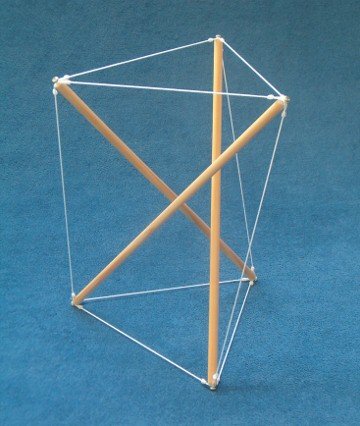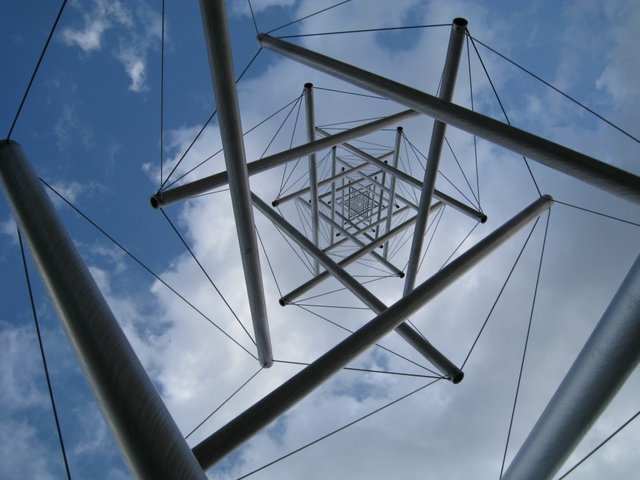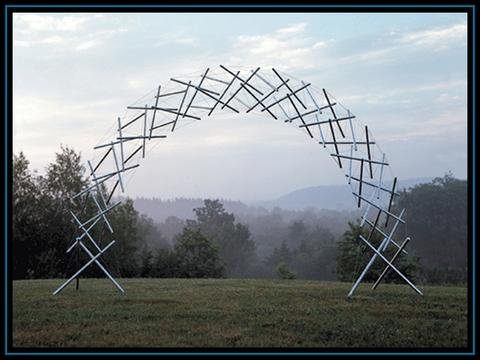Tensegrity Structures
This post originally was going to be an article for Lunyr, a descentralized Ethereum based Encyclopedia platform (in other words a descentralized Wikipedia), where you get paid for writing, however is needed to pay around 0,5$ or 0,001 ETH in order to publish it. I am from Venezuela and I do not have (at least not yet) that quantity in my wallets to pay, which is ironic because the page says i'll get 2$ by publish it. Here's the proof : https://steemitimages.com/DQmSZwaeTRZpjv5UdSsYGCYUGm8STCAq7kgMbM7NLBH327v.
So I want to share this on Steemit, because I can't in Lunyr! Anyway, this is the article:
...
Tensegrity Structures
Tensegrity structures are structural systems based on elements subjected to tension: they consist of compression elements that do not touch each other, joined only by traction components. According to the general definition, only axial forces act on the tensegrity structures, there are no shear forces or bending momentums on the elements of this type of structures.

Brisbane, Queensland
The Tensegrity is a relatively new and developing system (50 years old). Three characters have been considered as the inventors of the Tensegrity: Richard Buckmister Fuller[1] (USA-1962), David Georges Emmerich (France-1964) and Kenneth D. Snelson[2] (USA-1948). Generally it has been given an architectural use, however it has a great potential for applications in engineering.
Concept
Different specialists in the field have established various definitions. Valentin Gomez Jauregui[3], in an attempt to explain clearly but in detail what the word "tensegrity" denotes, suggests defining it like this:
 "Simplex" by Kenneth Snelson[10]. Simplest tensegrity structure.
"Simplex" by Kenneth Snelson[10]. Simplest tensegrity structure.“Tensegrity is a structural principle based on the use of compressed isolated components that are within a continuous tensioned network, so that the compressed members (usually rods) do not touch each other and are only united by means of tensioned components ( usually cables) that are those that spatially delimit said system[3].”
The word Tensegrity comes from the contraction of "integrity" and "tensional", which was used by Fuller[1] in the early 60's.
There are many definitions for the Tensegrity concept:
"Islands of compression in an ocean of traction" (Kenneth Snelson[2])
"Continuous traction, discontinuous compression" (Buckminster-Fuller[1])
Perhaps the most accepted definition for a Tensegrity structure was given by Pugh [4]:
"A Tensegrity system is established when a set of discontinuous compression components interacts with a set of continuous traction components and defines a stable volume in space. [4]"
The original definition takes into account two types of elements: bars (compression) and cables (traction), said bars completely isolated from each other.
Characteristics
- Stable equilibrium: the system can recover its original position after some external action has moved it away from it; and by itself because said equilibrium is independent of any condition external to it, it does not depend on external forces, not even gravity or any anchoring, due to its initial prestressed state. It is stable even in the space outside the atmosphere.
- Components: this term is opposed to the term "element", used in other definitions, because just as it is generally a bar or a cable, it can also refer to a membrane, an air volume, an atom or an assembly of most elementary components.
- Compressed or pulled: instead of compressed and pulled, because the key is that each component, in its entirety, has to work compression or traction, not both at once or in a mixed way (as it could be considered bending momentum).
- Continuous tension and discontinuous compression: since, as mentioned, the compressed components must be isolated from each other, while those subjected to tension create an "ocean" of tension without discontinuity in nodes.
Advantages
- The network of multidirectional tensions encloses and assimilates the voluble efforts that appear in the structure, so there are no points of local weakness.
- Given the ability to behave as a whole, the use of materials is economically and economically feasible, offering high resistant values for a small amount of material.
- As Fuller[1] pointed out, tensegrities do not suffer from torsion, and buckling is a phenomenon rarely present in them due to the reduced slenderness of their compressed elements.
- The forces that appear in the set are transmitted through the shortest distance between the points encompassed in the resistant phenomenon, which is why its members are said to be positioned in the most suitable way to support those loads.
- The fact that these structures vibrate ostensibly in their entirety indicates that they are transferring forces very quickly, and therefore such efforts do not appear locally. This is very suitable for those cases in which it is necessary to absorb impacts or seismic vibrations. Consequently, they would be very useful in areas susceptible to earthquakes, earth movements, volcanic eruptions, etc.
- They have an exceptional ability to create systems that are more complex by assembling simpler ones.
- For large-scale structures, the construction process would be significantly facilitated by not needing such additional scaffolding constructions. The structure itself serves as a scaffold for itself.
Disadvantages
- The tensegritical groupings have yet to solve the problem of bar congestion. As some designs grow in size, their uprights begin to interfere with each other.
- According to Ariel Hanaor[5], there is a "relatively high degree of deformation and poor material efficiency, compared to conventional geometrically rigid structures".
- The complex manufacture of these constructions is also a barrier to their development. The spherical and domed configurations are complicated to execute.
- To maintain the state of self-tension, it is necessary to subject them to a state of prestressing that would require very high forces for their stability, especially for those of large dimensions.
Applications in Engineering and Architecture
Domes

Towers

Arches

Others
References
[1] FULLER, R.B., “Tensegrity”, Portfolio and Art News Annual, No.4, 1961, pp.112-127, 144, 148. Also accessible in: http://www.rwgrayprojects.com/rbfnotes/fpapers/tensegrity/tenseg01.html
[2] SNELSON, K., Kenneth Snelson, [on-line], New York (USA). 2004-2008. Also accessible in: http://www.kennethsnelson.net
[3] GÓMEZ JÁUREGUI, V., Tensegridad. Estructuras Tensegríticas en Ciencia y Arte, Universidad de Cantabria, Santander, 2007, 200 pp. ISBN 978-84-8102-437-1
[4] PUGH, A., An Introduction to Tensegrity, Berkeley, California: University of California Press, 1976.
[5] http://journals.sagepub.com/doi/abs/10.1260/0266-3511.27.4.247
...
This has been my article about Tensegrity Structures, hope you found it interesting! @mery.morales25 @provenezuela @lyxng @shaularosa @munawar1235 @lawrenceho @curie
UpVote/Resteem
@acont Civil Engineering Student